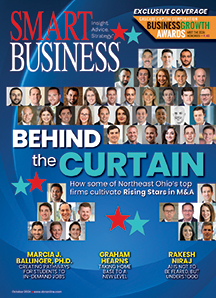
Scott Friedman and his team at Seegrid Corp., a developer of vision-guided robotic trucks, founded their company on the idea that taking the driver off of a forklift would be safer and save money. They didn’t know it at the time, but they were on to something big.
“We actually went out and we talked to about a dozen customers who are responsible for about $200 billion worth of retail spend,” Friedman, co-founder and CEO of the 60-employee company says. “It was tough to get the meetings, but we said, ‘If we were successful technologically and we made such a product that could work like this in your warehouses, would it mean anything to you or would it mean everything to you?’”
Seegrid’s innovations have impressed companies like Toyota and Kion Group, which are part of the $38 billion forklift market.
Smart Business spoke to Friedman about how he is growing his company in a niche market.
Market innovation. We had a very strong and informed vision of what we wanted to achieve. It was on the edges of realistic, so between early customers and knowledgeable technologists, we had a very strong product vision that everybody agreed could be achieved and would be of value.
We use a camera system and a bunch of advanced robotic software that we reduce the complexity of deploying a robot to something we call ‘walk through then work.” To make our products make deliveries in a big industrial space, somebody who works at the facility takes the equipment and walks it around and shows it the routes and when its doing that the cameras take a bunch of pictures and it builds a 3-D map of the facility like a video game map, and then afterward, it will repeat those routes that somebody has shown it.
Once we were able to get a product in the market, we had to listen twice as much as we talked. Listening is an active process, but you have to also watch because people can’t articulate everything they need. You have to be focused on understanding, listening, looking and documenting what works well and what doesn’t work well and what people said they need and don’t need. That is what will help your products take off.
Make tough choices. The true innovation is taking the thousand things you’ve heard and choosing to do just one. That’s the hardest thing, because it’s easy to compile wish lists but it takes a lot of conviction and courage to take all that in and say we have the resources and this is what the customers need to get to the next place, we are going to do a fantastic job on just this one. The hard part is figuring out the right one and really nailing it to the wall.
You have to look at what can propel the business. Everything has to be as simple as possible and still maintain fast growth. If you want the boat to go 50 miles per hour, you want as little dragging as possible. Simplicity is a requirement for speed. What’s the one thing on the list that you could do that will give you the speed, the pull-through and the growth?
Take it to the next level. There’s a point in businesses when you hit X millions in revenue and more than 35 or 40 people where it can’t be run out of the back pocket of a few people anymore. It has to be broken up into systems and management and all of that. In the past year, year and a half, we went through that transition. We broke the business apart and realigned it under more normal business functional units so it could scale.
That was a very big challenge. I think it was mostly around an honest look at what we were doing and where were we now and where did we want to go and how were we going to get there. You need a big dose of intellectual honesty because when you start a business and when you start growing it and it starts getting customers and you’re actually doing the thing, you don’t have a sense of its natural scale or its natural growth arch. Every business has its own course and it has very little to do with what you thought it would when you started it.
That’s very tough for people who start businesses to pull back, and it’s like looking at your own kids. You have to pull back and look at it, not just passionately but out of the context in which you built it to understand what it needs and what it really is. If the founders are going to make that move, they have to understand that the thing that sustained the early days is not the thing that’s going to make you successful going forward. You have to really understand what your business is and what potential it has and what potential it doesn’t have.
HOW TO REACH: Seegrid Corp., (877) 733-4743 or www.seegrid.com

